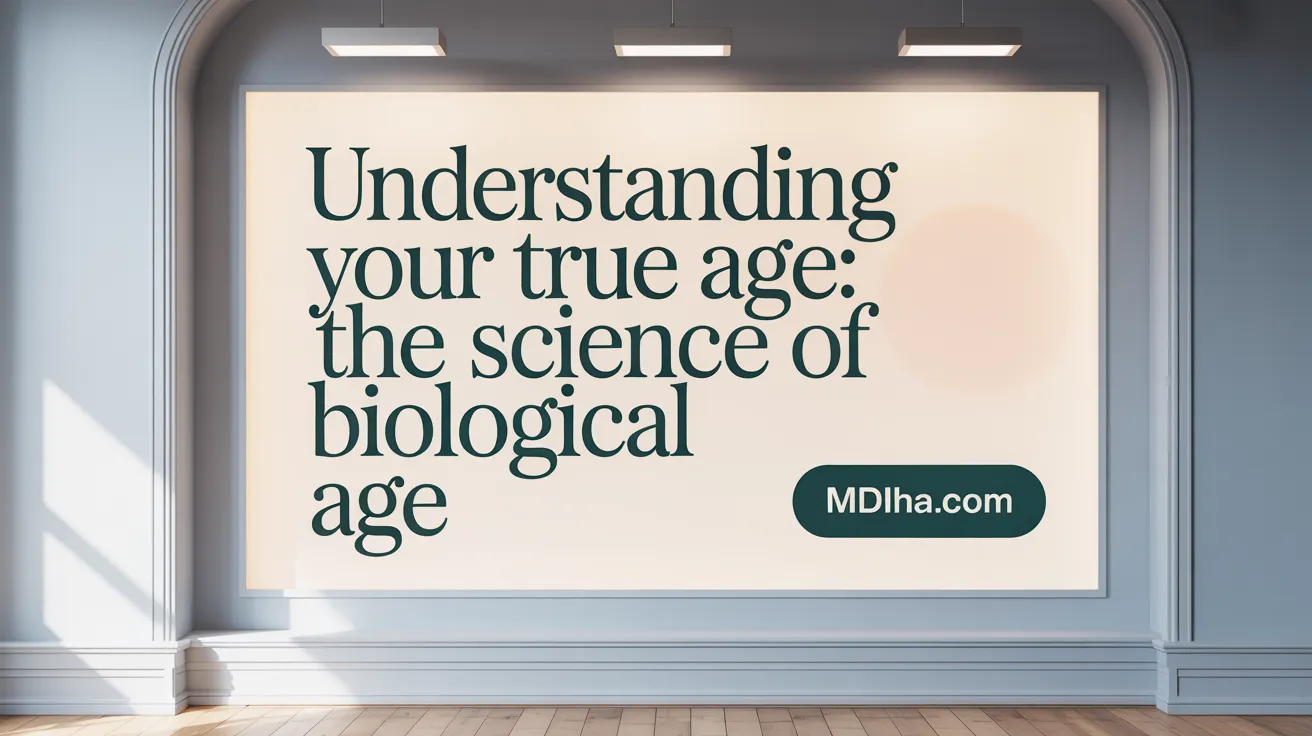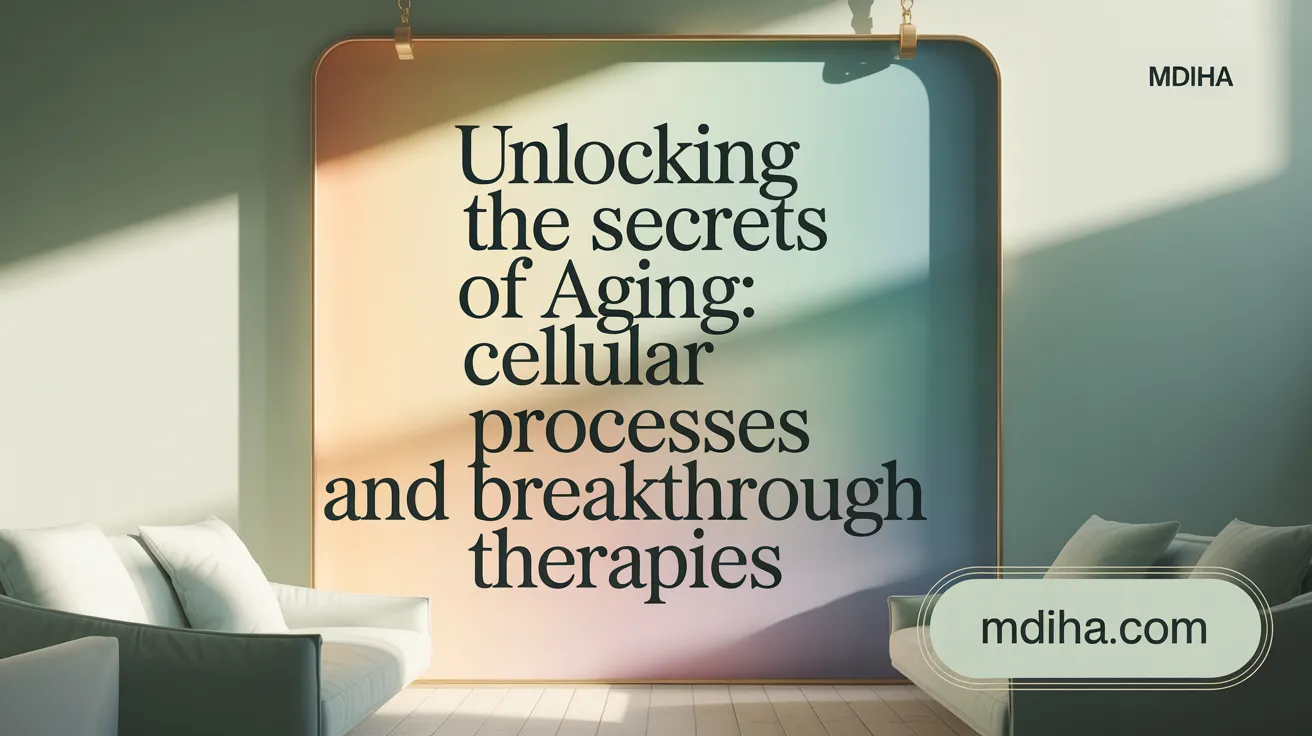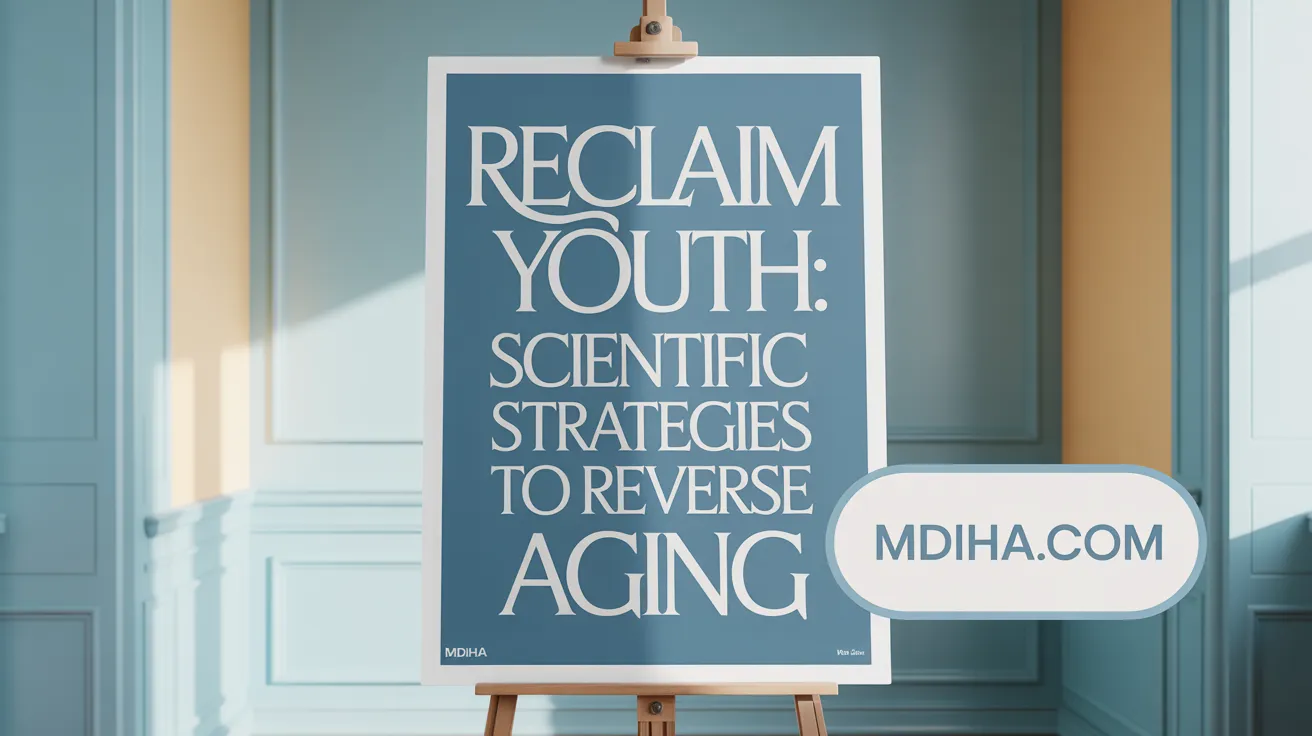Understanding the Essence of Biological Age
Biological age reflects the true functional state of our body's systems, offering a deeper insight into health and aging than mere chronological years. Unlike the age shown on our birth certificate, biological age is a dynamic measure influenced by genetics, lifestyle, and environmental factors, measured through advanced biomarkers like DNA methylation clocks. As scientific research advances, deciphering and modulating biological age emerges as a frontier for enhancing vitality, extending healthspan, and reversing age-related decline. This article explores scientific strategies, lifestyle interventions, and cutting-edge research aimed at reducing biological age, revealing a pathway toward improved wellness and longevity.
Decoding Biological Age: Its Significance in Aging and Health

What is biological age, and why is it important for understanding aging and health?
Biological age measures how well our body's cells, tissues, and systems are functioning, which often differs from our chronological age—the number of years since birth. It provides a snapshot of our physiological state, indicating the true level of aging within our bodies.
Scientists assess biological age using various biomarkers, including DNA methylation patterns (epigenetic clocks), telomere length, physical assessments like frailty indices, and advanced molecular tests. These tools offer a more accurate picture of health status than merely counting chronological years.
Understanding biological age is vital because it correlates strongly with risks of age-related diseases, mortality, and overall vitality. A lower biological age compared to chronological age suggests better health and resilience, while a higher biological age indicates increased health risks.
This measurement enables personalized health predictions and targeted interventions, helping individuals adopt lifestyle, dietary, or medical strategies to slow down aging processes. It also serves as a critical marker in aging research, guiding the development of therapies aimed at reversing or slowing biological aging.
By distinguishing biological from chronological age, researchers and healthcare providers can emphasize the importance of lifestyle choices—such as diet, exercise, sleep, and stress management—in influencing our body's aging rate. Ultimately, understanding biological age empowers better health management, promotes longevity, and enhances quality of life.
The Biology Behind Aging: Cellular Processes and Innovative Healthspan Extension

What are the biological processes and mechanisms involved in aging, and what innovative approaches aim to extend healthspan?
Aging occurs due to a multitude of interconnected biological processes that lead to the gradual decline of bodily functions. Central to this are cellular senescence, mitochondrial dysfunction, telomere shortening, and genomic instability. As cells reach a point where they can no longer divide or repair damage efficiently, they enter a state called senescence, releasing inflammatory factors that contribute to tissue deterioration.
Mitochondria, the energy-producing structures within cells, become less efficient over time, resulting in reduced energy output and increased production of reactive oxygen species, which damage DNA and other cellular components. Telomeres, the protective caps at the ends of chromosomes, shorten with each cell division, eventually triggering cell aging or apoptosis.
Chronic inflammation, often called "inflammaging," exacerbates these effects, promoting tissue damage and heightening disease risk. At the molecular level, pathways such as mTOR and insulin/IGF-1 sensing regulate growth and metabolism, but their overactivation accelerates aging processes.
Innovative therapies focus on targeting these underlying drivers. Gene therapy offers potential by enhancing telomerase activity to lengthen telomeres or activating sirtuins like SIRT6 to promote healthy aging. Senolytics are drugs designed to selectively eliminate senescent cells, reducing their harmful influence on tissues.
Regenerative medicine, including stem cell therapy, aims to replenish declining cell populations. Gene editing tools like CRISPR enable correction of mutations that contribute to age-related diseases. Recent advancements in delivery technologies, such as proteo-lipid vehicles, allow for precise targeting and systemic application of these genetic interventions, maximizing their potential.
Alongside these biological strategies, lifestyle factors remain crucial. Regular exercise, a balanced diet, quality sleep, and stress management can modulate molecular pathways, lower inflammation, and support cellular maintenance, collectively helping to extend healthspan and delay aging-related decline.
| Aspect | Biological Process | Innovative Approach | Impact |
|---|---|---|---|
| Cellular Senescence | Cell cycle arrest, inflammation | Senolytics, gene therapy for telomere extension | Reduce tissue inflammation and promote regeneration |
| Mitochondrial Dysfunction | Energy decline, ROS accumulation | Mitochondrial-targeted antioxidants, NAD+ precursors | Improve cellular energy and reduce oxidative damage |
| Telomere Shortening | Chromosome protection loss | Telomerase activation | Sustain cell proliferation capacity |
| Genomic Instability | DNA damage accumulation | CRISPR gene editing, DNA repair enhancement | Correct mutations, reduce disease risk |
| Chronic Inflammation | Tissue damage, disease promotion | Anti-inflammatory therapies, lifestyle modulations | Lower inflammaging and preserve tissue health |
Understanding these complex biological mechanisms opens avenues for developing therapies that could not only slow aging but potentially reverse some of its effects, paving the way toward healthier, longer lives.
Scientific Strategies and Interventions to Reduce Biological Age

What scientific strategies and interventions are currently known to reduce biological age and promote healthy aging?
Modern aging research is rapidly expanding its arsenal of strategies aimed at reversing or slowing the biological clock. These interventions target fundamental aging mechanisms, including cellular damage, senescence, and molecular decline.
Pharmacological approaches are gaining prominence. Drugs like metformin, originally developed for diabetes, are being studied for their potential to improve metabolic health and delay age-related diseases. Rapamycin, an immunosuppressant, has shown promise in extending lifespan in animal models by modulating cellular growth pathways. Similarly, senolytics are a class of drugs designed to selectively eliminate senescent cells, which contribute to chronic inflammation and tissue dysfunction.
Innovative biological techniques include cellular reprogramming, where factors such as Oct4, Sox2, Klf4, and c-Myc are used to revert aged cells to a more youthful state, demonstrated in cell cultures and animal experiments. Heterochronic parabiosis, the joining of blood circulation between young and old organisms, suggests that circulating young blood components can induce systemic rejuvenation, potentially through dilution of damage and beneficial factor transfer.
Measuring the success of these therapies relies heavily on epigenetic clocks—DNA methylation-based biomarkers that give a precise estimate of biological age. They help gauge intervention efficacy and guide personalized treatments.
Addressing inflammation and metabolic health plays a vital role. Strategies to reduce chronic inflammation, improve mitochondrial function, and regulate blood sugar levels contribute significantly to healthy aging. Lifestyle habits such as a nutritious diet rich in vegetables, fruits, and healthy fats, coupled with regular physical activity and quality sleep, support these goals.
Finally, integrating holistic approaches like yoga and stress management not only improve mental well-being but also influence biological pathways, reducing oxidative stress and preserving telomere length.
Together, these strategies—whether pharmaceutical, biological, or lifestyle-based—are focused on repairing molecular damage, sustaining cellular function, and extending the period of healthful life, embodying a comprehensive approach to combating aging.
Lifestyle, Dietary, and Behavioral Impact on Biological Aging

How do lifestyle, dietary, and behavioral changes contribute to slowing down or reversing biological aging?
Recent scientific studies show that our daily choices can significantly influence the aging process at a molecular and cellular level. Interventions focused on diet, exercise, stress management, and sleep have demonstrated tangible effects on biological age.
One notable example is an 8-week program combining diet, sleep, exercise, relaxation techniques, supplements, and coaching. This approach led to an average reduction of about 4.6 years in biological age among participants, as measured by DNA methylation clocks such as the Horvath DNAmAge. This evidence underscores the potential for short-term lifestyle modifications to improve systemic resilience, cellular repair, and overall health.
Consistently following healthy dietary patterns, such as the Mediterranean diet rich in vegetables, fruits, legumes, nuts, and whole grains, can help reduce inflammation and support a balanced microbiome—both linked to slower aging. Conversely, diets high in processed foods, refined carbs, and sugars may accelerate age-related decline.
Regular physical activity, including resistance training and aerobic exercises, has been associated with decreased biological age. Exercise improves mitochondrial health, muscle mass, and cardiovascular function, all vital for maintaining youthful physiology.
Stress management techniques like yoga and meditation help modulate chronic inflammation and oxidative stress, which are central to the aging process. Adequate sleep, typically 7–8 hours night, is essential for reducing accumulation of toxic proteins in the brain and supporting cellular repair; too little or excessive sleep correlates with increased health risks.
Additional factors include practicing good oral hygiene and protecting the skin from UV damage through sunscreen and sunglasses. These behaviors minimize damage from environmental stressors that promote skin aging, DNA mutations, and inflammation.
Emerging research leveraging multi-omics data and AI-driven personalization suggests that lifestyle interventions targeting genomic stability, mitochondrial function, and cellular cleanup can produce measurable benefits. For example, methylation-supportive diets and specific supplement regimens have shown promise in reducing biological age markers.
In summary, modifiable lifestyle factors—ranging from diet and exercise to stress reduction and proper sleep—play a crucial role in slowing or even reversing aspects of biological aging. The integration of scientific insights into everyday habits offers a promising pathway toward healthier, longer lives.
Biomarkers and Longevity Science: Foundations for Aging Reversal
What insights do scientific studies provide about biomarkers and longevity science related to aging reversal?
Scientific research has made significant advances in identifying biomarkers that can accurately measure and predict biological age, paving the way for interventions to reverse aging. Prominent among these are epigenetic clocks, such as the Horvath DNAmAge clock and DunedinPACE, which analyze patterns of DNA methylation across tissues. These tools serve as molecular indicators of aging rates and health risks.
In addition to epigenetic marks, telomere length has been studied as a marker of cellular aging, with shorter telomeres correlating with increased mortality and age-related diseases. Inflammatory markers, like C-reactive protein, also provide insights into the systemic aging process and chronic inflammation's role in age-related decline.
Innovative studies have highlighted the role of young blood factors, for example, TIMP2, which have shown potential in reversing age-related cognitive decline in animal models. Organ-specific markers—such as blood proteins, hormone levels, and tissue-derived signals—help quantify functional decline or rejuvenation in particular systems.
Advances are increasingly integrating multi-omics data—combining genomic, proteomic, metabolomic, and epigenomic profiles—often assisted by artificial intelligence (AI). This approach helps develop sophisticated algorithms that can comprehensively assess biological age and predict susceptibility to age-related diseases.
While current findings are promising, especially in demonstrating lifestyle interventions like calorie restriction, exercise, and improved sleep in slowing biological aging, the validation of these biomarkers for routine clinical application remains ongoing. The pursuit of reliable, accessible biomarkers continues, fueling hopes for targeted therapies that can genuinely reverse aging at the molecular level.
| Biomarker Type | Key Features | Clinical Relevance |
|---|---|---|
| Epigenetic clocks | DNA methylation patterns | Predict biological age, health span, lifespan |
| Telomere length | Chromosomal end caps | Indicator of cellular aging |
| Inflammatory markers | Cytokines, CRP | Systemic inflammation linked to aging |
| Organ-specific markers | Blood proteins, hormones | Functional status of organs |
| Young blood factors | TIMP2, GDF11 | Potential to reverse neurodegeneration |
| Integrative omics | Multi-layered molecular data | Personalized aging profiles |
Understanding and validating these biomarkers are crucial steps toward developing therapies that can extend healthspan and perhaps even reverse aspects of biological aging, leading to healthier, longer lives.
Emerging Evidence-Based Methods to Enhance Vitality via Biological Age Reduction
What emerging research and evidence-based methods are available to enhance vitality and wellness through reducing biological age?
Recent advancements in aging research have opened new pathways to potentially reverse biological aging. Biomarkers like epigenetic clocks—which analyze DNA methylation patterns—are fundamental tools in this effort. Studies show that interventions such as targeted nutritional supplements, lifestyle modifications, and innovative therapies can influence these biomarkers and promote systemic rejuvenation.
Nutritional strategies, for instance, combining omega-3 fatty acids with vitamin D, alongside structured exercise routines, have demonstrated significant reductions in biological age based on DNA methylation clocks like PhenoAge and GrimAge. These approaches are associated with improvements in organ function, physical resilience, and overall health markers.
Exercise plays a crucial role, with regular, varied physical activity showing promise in reversing epigenetic age and enhancing muscle strength, cardiovascular health, and mental clarity. Both aerobic and resistance training help maintain cellular vitality and offset age-related decline.
Beyond lifestyle, novel therapeutics are emerging. NAD+ boosters, such as NMN, support mitochondrial function and cellular energy. Sirtuin activators and plant-based supplements like the Cel System target pathways related to genomic stability, mitochondrial health, and cellular cleanup, collectively contributing to slowing or reversing aging processes.
Advances in systemic rejuvenation techniques include in vivo reprogramming, which involves resetting cellular identity, and heterochronic transplantation—methods where young blood factors or regenerative cells induce systemic renewal.
Integrating these approaches with biomarker assessments allows for personalized health plans. Regular monitoring of epigenetic age alongside physical and molecular markers helps tailor interventions, maximizing benefits for each individual.
Overall, the convergence of dietary modifications, exercise, advanced therapeutics, and biomarker-guided personalization offers a comprehensive strategy to enhance vitality and possibly extend healthspan by reducing biological age.
The Role of Mental and Physical Wellness Practices in Slowing Biological Aging
How do mental and physical wellness practices like meditation and yoga impact biological aging?
Mindfulness practices such as meditation and yoga play a significant role in slowing the biological clock by positively influencing key cellular and molecular markers of aging. These activities are known to reduce oxidative stress, DNA damage, and chronic inflammation—hallmarks that accelerate cellular aging.
Through regular practice, yoga and meditation enhance the body's antioxidant capacity, increasing enzymes and molecules that protect cells from damage. They also boost the activity of telomerase, an enzyme that preserves telomere length, a critical factor linked to cellular longevity. Improvements in sirtuin-1 levels, which support DNA repair and metabolic regulation, have been observed in individuals engaged in these practices.
Furthermore, wellness routines like yoga and meditation modulate the hypothalamic–pituitary–adrenal (HPA) axis, leading to decreased cortisol levels. Lower cortisol reduces systemic inflammation and protects tissues from degeneration. These practices also lower inflammatory cytokines such as IL-6 and reduce reactive oxygen species, which contribute to cellular aging.
Beyond physical benefits, yoga and meditation bolster immune function by enhancing lymphocyte activity and cytokine balance. They support mental clarity, emotional stability, and cognitive health—factors essential for maintaining resilience against age-related decline.
In essence, integrating mindfulness and physical movement into daily life can lead to systemic improvements at the molecular level. This holistic approach supports cellular resilience, delays the onset of age-related diseases, and promotes a vibrant, healthier aging process.
Case Study in Age Reversal: Insights from Bryan Johnson's Regimen
Comprehensive health tracking and biomarkers
Bryan Johnson, aged 47 in 2024, has become renowned for his detailed focus on biological age. Utilizing advanced testing methods, he continuously monitors various biomarkers such as DNA methylation, cardiovascular health, and organ function. His results show an impressive slowing of his aging process, with a biological age statistically lower than his chronological age. These measurements include cutting-edge epigenetic clocks like Horvath's Clock, which track DNA methylation patterns across tissues, providing precise insights into his cellular age.
Plant-based nutrient-rich diet and supplement use
Johnson adheres to a strict, plant-based diet rich in vegetables, fruits, nuts, and whole grains. His meals are supplemented with scientifically supported antioxidants, NMN to support mitochondrial health, and other nutrients like fisetin and EGCG, aiming to reduce oxidative stress and enhance cellular repair mechanisms. His diet's purpose is to minimize factors that accelerate aging, such as inflammation and glycation.
Rigorous sleep and exercise routines
Sleep plays a vital role in his health regimen, with Johnson ensuring 8 hours of quality sleep per night in a dark, temperature-controlled environment. His physical activity includes daily strength training and stamina exercises, which help maintain muscle mass and cardiovascular health. His commitment to consistent exercise and proper sleep contribute significantly to his slowed aging trajectory.
Advanced skin and dental care
Johnson invests in extensive skincare, including acid peels, laser therapies, and red light treatments to preserve youthful skin. He also maintains diligent dental care, regularly monitoring oral health markers like plaque levels and teeth attachment loss. These efforts aim to reduce external aging signs and prevent age-related oral health issues.
Experimental therapies including gene therapy and plasma transfusions
He explores experimental options, such as gene therapy to boost proteins linked to longevity and plasma transfusions from younger individuals to potentially introduce beneficial youthful factors. While controversial, these methods are grounded in scientific research suggesting they might influence systemic aging markers.
Scientific validation and monitoring
Johnson's approach is driven by rigorous scientific validation. He actively tracks biological markers through blood tests, imaging, and genetic screening. His efforts are backed by real-time data, ensuring that his methods are scientifically sound and adjustable based on the latest research.
| Approach | Focus Area | Standard Measurements |
|---|---|---|
| Biomarker tracking | Molecular and physiological health | DNA methylation, organ function tests, imaging |
| Nutritional interventions | Cellular damage prevention | Biomarker levels for oxidative stress, inflammation |
| Sleep and exercise routines | Physical resilience and repair | Muscle mass, cardiorespiratory capacity |
| Skin and dental care | External appearance and health | Skin elasticity, oral health markers |
| Experimental therapies | Systemic rejuvenation | Longevity proteins, plasma biomarkers |
Understanding and implementing such multifaceted measures may pave the way for effective aging reversal therapies, emphasizing the importance of continuous monitoring and scientific validation in health optimization.
Practical Technologies and Wellness Therapies Supporting Biological Age Reduction
Diagnostic Services Measuring Biological Age
Modern wellness centers offer comprehensive diagnostic tools that evaluate biological age by analyzing molecular and physiological markers. These assessments often include DNA methylation tests, such as the Horvath clock, to determine the aging rate at a cellular level. Physical tests, like gait speed, grip strength, and balance, provide additional insights into a person's functional age. Accurate biological age measurements help individuals understand their health status and tailor personalized interventions to promote longevity.
Therapeutic Modalities Like Acoustic Wave Treatment and Red Light Therapy
Emerging therapies are designed to enhance tissue regeneration and cellular health. Acoustic Wave Treatment uses sound waves to stimulate blood flow and promote the repair of damaged tissues. Red Light Therapy exposes the skin to specific wavelengths that penetrate tissues, reducing inflammation and supporting mitochondrial function. Both modalities can improve skin vitality, reduce joint pain, and enhance overall physical well-being, contributing indirectly to slower biological aging.
IV Hydration and Its Wellness Benefits
IV hydration therapy delivers fluids, vitamins, and antioxidants directly into the bloodstream, ensuring rapid absorption and optimal hydration. This treatment can boost energy levels, improve skin health, and support immune function. Regular IV therapy may also help detoxify the body, reducing the load of harmful toxins that accelerate aging processes. Many individuals incorporate IV hydration as part of their holistic approach to maintaining vitality and health.
Importance of Personalized Health Monitoring
Continuous health monitoring using advanced imaging, genetic testing, and blood analysis enables a tailored approach to slowing aging. Regular tracking of biological markers allows for the adjustment of diet, supplements, and therapies to maximize effectiveness. Personalized insights foster proactive health management, helping to maintain physical and mental function at optimal levels. This tailored strategy is crucial in the pursuit of systemic biological age reversal.
Cost-Effectiveness of Lifestyle Changes Versus Extreme Measures
While cutting-edge treatments like gene therapies and experimental drugs can be costly and uncertain, evidence suggests that lifestyle modifications offer significant benefits at a much lower cost. Adopting a healthy diet rich in vegetables and whole grains, engaging in regular physical activity, ensuring adequate sleep, and managing stress can substantially slow biological aging. These practical, affordable strategies promote longevity and wellness without the risks and expenses associated with more invasive or experimental interventions.
Integrating Physical Activity and Muscle Maintenance for Longevity

Resistance training delaying muscle aging
Resistance exercises, such as weightlifting or bodyweight workouts, are vital for maintaining muscle mass as we age. These activities help delay sarcopenia, the gradual loss of muscle tissue, which is a hallmark of aging. Consistent strength training stimulates muscle fibers, promotes protein synthesis, and supports metabolic health.
Walking and cardiovascular fitness effects
Regular walking is a simple, accessible way to enhance cardiovascular health. It improves blood circulation, reduces blood pressure, and boosts endurance. Walking also contributes to overall physical resilience and can slow biological aging markers, including those detectable through epigenetic assessments.
Impact of physical activity on biological age indicators
Studies have linked physical activity levels with reductions in biological age, measured through DNA methylation clocks like Horvath’s. Engaging in regular movement can influence biomarkers associated with aging by decreasing inflammation, oxidative stress, and cellular damage, thus supporting healthier, extended lifespans.
Synergy with diet and supplements
Combining exercise with a nutrient-rich diet and targeted supplements amplifies aging defenses. For example, good nutrition supports muscle repair and recovery, while supplements like NMN and antioxidants can enhance mitochondrial function and reduce oxidative stress. This integrated approach offers more robust benefits than isolated interventions.
Role in preventing frailty and sustaining independence
Physical activity, especially resistance training and walking, helps prevent frailty—a decline in physical function often seen in older adults. Maintaining muscle strength and cardiovascular resilience ensures mobility, reduces fall risk, and supports independence over the lifespan.
| Activity Type | Benefits | Additional Notes |
|---|---|---|
| Resistance training | Preserves muscle mass, delays sarcopenia | Effective when performed regularly, tailored to individual capacity |
| Walking | Improves cardiovascular health, supports mental well-being | Easy to incorporate into daily routine |
| Combined approaches | Enhances overall vitality, influences biological age markers | Synergistic effects boost longevity potential |
| Lifestyle integration | Prevents frailty, sustains independence | Critical for quality aging, complementing diet and supplements |
Future Directions: Toward Systemic Rejuvenation Therapies
Combining damage dilution and youthful factor introduction
Emerging rejuvenation strategies are increasingly focusing on systemic approaches aimed at reducing biological age rather than merely slowing aging. Two promising methods are damage dilution and the introduction of youthful factors. Damage dilution involves reducing accumulated cellular damage and molecular debris, thereby restoring cellular function. Complementing this, introducing youthful factors—such as specific proteins or blood components—can stimulate regenerative pathways. Techniques like heterochronic transplantation, exemplified by parabiosis, showcase how circulating young blood or beneficial factors can reverse signs of aging across multiple tissues.
Senescent cell clearance and autophagy enhancement
A crucial aspect of rejuvenation is addressing cellular senescence, which contributes to tissue dysfunction and inflammation. Clearing senescent cells using senolytics—drugs that selectively eliminate these dysfunctional cells—has shown promising results in animal models. Alongside, enhancing autophagy, the cellular recycling process, can remove damaged organelles and proteins, promoting cellular health. These interventions target key hallmarks of aging, paving the way for more systemic rejuvenation effects with potential applications in human therapies.
Potential role of gene editing and delivery systems
Gene editing technologies, like CRISPR-Cas systems, hold potential for correcting age-related genetic mutations and upregulating genes associated with longevity. Delivery systems such as viral vectors or nanoparticles can target specific tissues, enabling precise modulation of genetic and epigenetic factors involved in aging. Future therapies may involve editing genes to boost cellular maintenance and repair processes or to silence pro-aging pathways, offering a customizable approach to systemic rejuvenation.
Harnessing embryonic cellular mechanisms
Natural rejuvenation during embryogenesis—around gastrulation—reaches the lowest biological age phase. Understanding the molecular mechanisms driving this natural process could reveal targets for therapy. Inspired by embryonic development, scientists aim to mimic these cellular states using reprogramming factors or cellular reset techniques to induce a youthful state in adult tissues. Such approaches may unlock systemic rejuvenation by reactivating innate cellular repair pathways.
Challenges and prospects for clinical translation
Despite promising developments, translating these strategies into safe and effective human therapies presents challenges. Risks include unintended genetic modifications, immune reactions, and ethical concerns. Robust clinical trials, advanced delivery systems, and a deeper understanding of aging biology are essential. Nonetheless, the synergy between damage control, youthful factor introduction, gene editing, and embryonic mechanism harnessing offers a comprehensive blueprint for future systemic rejuvenation therapies aimed at extending healthspan and lifespan.
Charting a Wellness-Oriented Future Through Biological Age Reduction
Reducing biological age offers a transformative approach to enhancing vitality, wellness, and longevity that transcends traditional notions of aging. Grounded in rigorous scientific understanding of aging mechanisms and supported by a wealth of emerging evidence, interventions spanning lifestyle modification, cutting-edge therapies, and integrative wellness practices hold great promise for extending our healthspan. Personalized biomarker assessments enable targeted, effective strategies that address the root causes of aging, while mindful mental and physical wellness approaches complement these efforts to optimize our quality of life. As research advances, systemic rejuvenation therapies may soon shift from experimental to mainstream, and the journey to turn back the clock on aging becomes an achievable frontier for many. Empowered with knowledge and actionable insights, individuals can embrace the path of reducing biological age to unlock a fuller, more vibrant life.
References
- Emerging rejuvenation strategies—Reducing the biological ...
- Understanding Your Biological Age: A Path to Longevity
- 9 simple, science-backed changes that can reverse your ...
- Potential reversal of biological age in women following an ...
- Lowering Biological Age: The Next Health & Wellness Craze
- Bryan Johnson's age: How he reversed it [and how you can ...
- New Trial Links Combo Supplement to Increased Strength ...
- Neurobiological and anti-aging benefits of yoga
- Can we slow aging? | National Institutes of Health (NIH)
